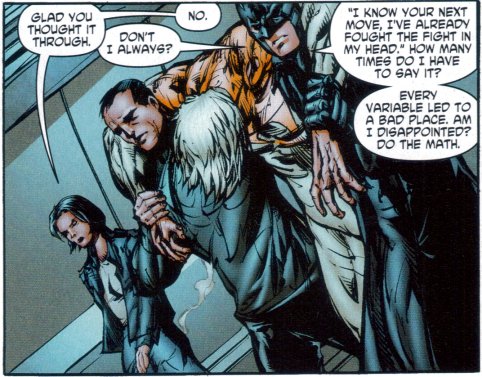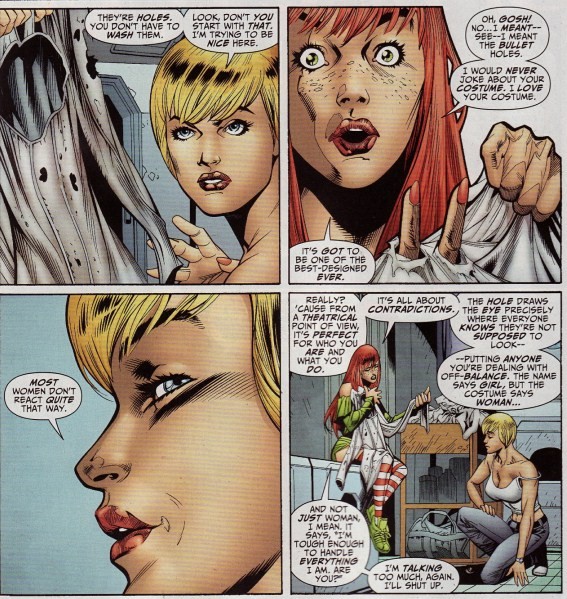Two things surprised me about Keitaro Takahashi’s Jormungand 1 after I finished it. The first was just how much I enjoyed reading it. The second was the fact that Kate Dacey (review on MangaCritic) and Danielle Leigh (review on CSBG) didn’t like it. I usually agree with their reviews, and if I disagree with one writer, then I agree with the other. To have both of them dislike something I dug feels weird.
Regardless! I don’t think I can explain why I like Jormungand without explaining my experience with Black Lagoon. I’d had Black Lagoon recommended to me by several people who thought I’d dig it. It hit a lot of my interests, but never clicked. The script was a little too Tarantino, the dialogue a little too consciously gritty and vulgar, and the action a little too Matrix. Revy’s portrayal felt overbearing. Guns akimbo, booty shorts, bad attitude, and tragic past do not a compelling character make. I think I quit the series seven or eight episodes before the end, just due to being tired of the entire affair.
Jormungand, though, hits the spot in a way Black Lagoon didn’t, but should have. I think that the secret is in its approach. Where Black Lagoon reveled in its excess, Jormungand manages to tone it down a little, but still be fun. Koko Hetmatyr, the leader of an arms-dealing firm, is (and I’m being 100% serious here) a blend of Misato Katsuragi from Evangelion, Sailor Moon, and Sir Integras Hellsing poured into the mold of an arms dealer. Excitable, and seemingly immature, but very, very good at her job. Kate describes her as “garrulous and profane,” and that’s on the money. Rivals underestimate her because she just seems like a young girl in over her head. And then the rivals get shot in the face, because whoops, she knows exactly what she’s doing, and she’s better at it than they are.
Koko’s newest hire is Jonah, a very young kid and experienced child soldier. Takahashi dances in and out of the real tragedy of being a child soldier, picking and choosing what can make a solid story. Jonah doesn’t sleep in a bed. He sleeps in a corner, wrapped up in a blanket, and with a gun in his hand. He’s quiet and withdrawn, almost sullen, and rarely asks questions.
At the same time, he’s very good at his job. He carefully watches possible enemies, delivers that info to his team, and isn’t afraid of pulling the trigger with a detached facial expression. He hates weapons, due to his parents being killed in a war, but he’s good at using them and joins Koko’s company of his own volition. There’s something bubbling in the background there, like Jonah is looking for the people directly responsible for killing his parents, or revenge, or something. There are a couple of brief interludes that seem to suggest as much.
The rest of the team are a motley crew. There’s the old guy who is probably a little washed up, but thinks higher of himself than he really deserves. There’s the girl with an eyepatch and a crush on Koko, who is apparently the best of the best. Think Sakaki from Azumanga Daioh with a knife and one eye. The rest of the cast is a little undefined, but undefined in a way that makes me assume they’ll be fleshed out in the future. They behave like a family, rather than a company, with gentle ribbing, bad cooking, and ridiculous jokes (“A mummy!”) being the order of the day.
The art does one thing I don’t know that I’ve seen in a book before, but really enjoyed. When time passes, the last panel on the page before the change or the first page after has a portion of it cut out and shadowed, kind of like a fade-in/fade-out effect. It isn’t 100% successful, but it is an interesting way to show the passage of time. The art is enjoyable, though it waffles between mostly realistic and anime/manga cliche exaggeration a little too often for my tastes.
Takahashi gets the hardware right, though. There’s a great shot of anti-air equipment, the guns look great, and the BDUs are believable, but still cool looking. The combat only gets overly flashy a couple of times, but when it gets down to brass tacks, it’s very straightforward. And hey, people practice trigger discipline, which is always nice to see in books. Takahashi did his homework. Not quite to the extent that Kenichi Sonoda did with Gunsmith Cats, but close enough for government work.
I liked Jormungand 1. I can see why Kate and Danielle didn’t, but something about it just worked for me. It feels a little like Gunsmith Cats with the gun fetish and light humor, which I am 2009% okay with. The casual approach to violence (the full page dedicated to Jonah using a handgun in the second chapter, the knife fight in the woods for seriously no good reason [as acknowledged by the fighters]) is something that’s morally reprehensible but, pretty entertaining. If the quality of the plotting and characterization picks up, this could be something very cool. As-is, it’s a shallow romp, but a fun one.











